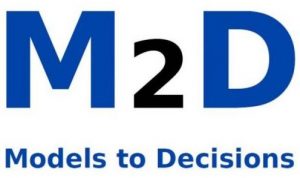The M2D network will run and promote activities and also fund projects based on three central themes:
 Uncertainty Quantification. The first theme is concerned with UQ. How do we propagate uncertainty about inputs through complex, expensive models to outputs? How do we quantify uncertainty about the model structure itself? Even where we have a good physical description of the system, such as the Navier-Stokes equations for fluid flow, there are uncertain elements in the model structure (e.g., sub-grid scale processes). If available, we can use observations of the real system to reduce the uncertainty in the inputs (inverse modelling) but this introduces complex challenges. There is always a difference between our models and the real system. Inverse modelling that simply minimizes the difference between observations and model outputs will tend to ‘overfit’, yielding misleading results. Thus, inverse modelling needs to jointly estimate both the model discrepancy and the ‘best’ input values. The network will encourage the development of new UQ methodology, both for the forward and inverse problem, and interactions between academics and decision makers. Challenges include: the large scale of modern problems in terms of model and data size, long chains of models, and the need for “real-time” methods for sequential decision-making.
Uncertainty Quantification. The first theme is concerned with UQ. How do we propagate uncertainty about inputs through complex, expensive models to outputs? How do we quantify uncertainty about the model structure itself? Even where we have a good physical description of the system, such as the Navier-Stokes equations for fluid flow, there are uncertain elements in the model structure (e.g., sub-grid scale processes). If available, we can use observations of the real system to reduce the uncertainty in the inputs (inverse modelling) but this introduces complex challenges. There is always a difference between our models and the real system. Inverse modelling that simply minimizes the difference between observations and model outputs will tend to ‘overfit’, yielding misleading results. Thus, inverse modelling needs to jointly estimate both the model discrepancy and the ‘best’ input values. The network will encourage the development of new UQ methodology, both for the forward and inverse problem, and interactions between academics and decision makers. Challenges include: the large scale of modern problems in terms of model and data size, long chains of models, and the need for “real-time” methods for sequential decision-making.
 From Model to Decision. The second theme is concerned with how we use outputs of models to make decisions. Part of this problem is mathematical. In many circumstances there is a chain of models leading to the making of a decision. In an air pollution problem we may need to model the traffic flow (the production of noxious gases), the small scale meteorology (how the gases move), atmospheric chemistry (how they combine) and the effect of pollutants on asthmatics’ health before we can decide to issue a warning or not. These models will have varying degrees of complexity and some might only involve expert opinion. Propagating uncertainty through such a chain of models is difficult if we are to avoid the uncertainty ‘ballooning’ because we have not taken the interactions between the models into account. The major part of this theme is concerned with psychology and social science. Decision makers have their own personal internal uncertainty. Different decision makers faced with the same evidence can quite rationally produce different decisions. How do decision makers combine this personal uncertainty with the mathematically derived uncertainties coming from the modelling? What advice can we give to make the process better? The network will enable meaningful discussions between researchers and users in areas that rarely talk to one another.
From Model to Decision. The second theme is concerned with how we use outputs of models to make decisions. Part of this problem is mathematical. In many circumstances there is a chain of models leading to the making of a decision. In an air pollution problem we may need to model the traffic flow (the production of noxious gases), the small scale meteorology (how the gases move), atmospheric chemistry (how they combine) and the effect of pollutants on asthmatics’ health before we can decide to issue a warning or not. These models will have varying degrees of complexity and some might only involve expert opinion. Propagating uncertainty through such a chain of models is difficult if we are to avoid the uncertainty ‘ballooning’ because we have not taken the interactions between the models into account. The major part of this theme is concerned with psychology and social science. Decision makers have their own personal internal uncertainty. Different decision makers faced with the same evidence can quite rationally produce different decisions. How do decision makers combine this personal uncertainty with the mathematically derived uncertainties coming from the modelling? What advice can we give to make the process better? The network will enable meaningful discussions between researchers and users in areas that rarely talk to one another.
 Communicating Uncertainty. The third theme tackles the communication and visualization of uncertainty. This is notoriously difficult, but is a hot topic. The KTN SIG on UQ&M recently held a meeting on visualisation and AHRC has also held events in this area. We will engage decision makers to explore salient and useable means of communicating and visualising uncertainty. The traditional method is to put an error bar or confidence limit around plots on a graph or to use box plots. However, such methods do not work for uncertain functions or maps. Interactivity offers new ways to approach this problem. We do not only communicate uncertainty through pictures. We also use text and tell narratives. There are great opportunities here for researchers in the humanities to improve the way we communicate uncertainty to decision makers. The network will encourage new and creative thinking on methods of visualising and presenting uncertain information to decision makers. We will encourage the take up of best practice and illustrate it through examples on a web site and in a newsletter (including code and data sets where available).
Communicating Uncertainty. The third theme tackles the communication and visualization of uncertainty. This is notoriously difficult, but is a hot topic. The KTN SIG on UQ&M recently held a meeting on visualisation and AHRC has also held events in this area. We will engage decision makers to explore salient and useable means of communicating and visualising uncertainty. The traditional method is to put an error bar or confidence limit around plots on a graph or to use box plots. However, such methods do not work for uncertain functions or maps. Interactivity offers new ways to approach this problem. We do not only communicate uncertainty through pictures. We also use text and tell narratives. There are great opportunities here for researchers in the humanities to improve the way we communicate uncertainty to decision makers. The network will encourage new and creative thinking on methods of visualising and presenting uncertain information to decision makers. We will encourage the take up of best practice and illustrate it through examples on a web site and in a newsletter (including code and data sets where available).

